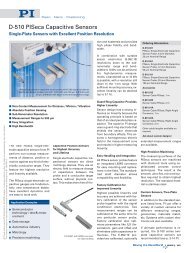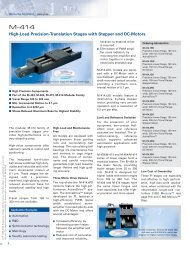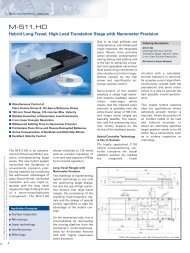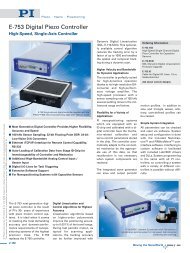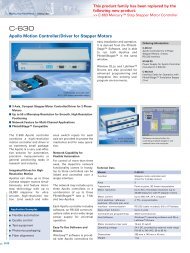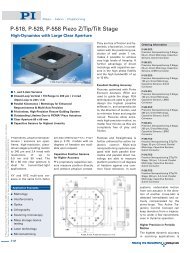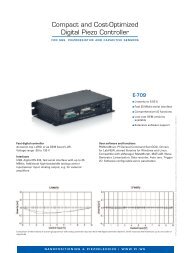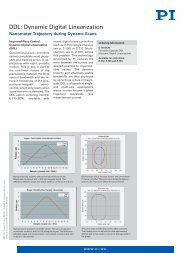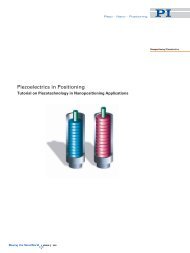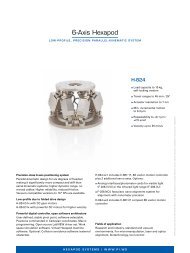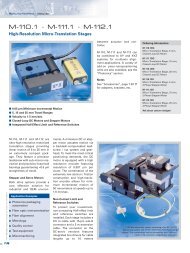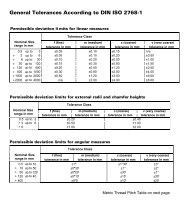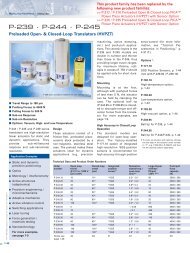Precision Gimbal Mount, Astronomy, Microscope Stage, Motorized ...
Precision Gimbal Mount, Astronomy, Microscope Stage, Motorized ...
Precision Gimbal Mount, Astronomy, Microscope Stage, Motorized ...
You also want an ePaper? Increase the reach of your titles
YUMPU automatically turns print PDFs into web optimized ePapers that Google loves.
TOPICS<br />
PIEZO NANO POSITIONING<br />
Continued from page 1<br />
Piezoceramic longitudinal and shear<br />
elements act on a moving rod coupled<br />
to the payload. This allows an arbitrarily<br />
small position resolution that only<br />
depends on the stability of the control<br />
voltage signal. While the rod can be<br />
moved in full-step mode at maximum<br />
velocity over long distances, the nanostepping<br />
mode allows uniform motion<br />
at a constant velocity. When de-energized,<br />
the drives provide maximum holding<br />
force with a nanometer stability,<br />
irrespective of their position.<br />
The Max Planck Institute<br />
for <strong>Astronomy</strong> (MPIA) in Brief:<br />
<strong>Astronomy</strong> is one of the oldest natural<br />
sciences and at the same time it is one<br />
of the most modern. This is proven by<br />
the Max Planck Institute for <strong>Astronomy</strong><br />
in Heidelberg. Here, researchers solve<br />
the mysteries of the universe with<br />
high-tech instruments, manufacture<br />
clever accessories and detectors for<br />
telescopes and satellites which examine<br />
the light from strange sources by<br />
every trick in the book. New stars and<br />
the birth of planetary systems are the<br />
objects of scientific curiosity. “Is Earth<br />
the only populated place in space?”<br />
is one of the burning questions in<br />
research. But the Max Planck astro nomers<br />
are also present in the depths<br />
of space and time, examining active<br />
galaxies and quasars to get a picture<br />
of the beginning and development<br />
of the now so richly structured universe.<br />
Precise and Stable: M-687 <strong>Microscope</strong> <strong>Stage</strong>s<br />
with Direct Drive<br />
With the M-687 PI offers a new, fast,<br />
high-precision XY positioning system<br />
optimized for applications with inverted<br />
microscopes.<br />
The M-687 XY stage provides travel<br />
ranges of up to 100 × 75 mm, and its<br />
large clear aperture of up to 160 × 100 mm<br />
can accomodate specimen holders as<br />
well as Z-specimen scanners. The currently<br />
available models can be used<br />
for Olympus IX2 series and for Nikon<br />
Eclipse TI inverted microscopes.The<br />
M-687 stage is driven by integrated<br />
PILine ® piezoceramic linear motors<br />
which, in contrast to flanged stepper or<br />
DC motors with large lead screw, ducts<br />
do not increase the footprint. This facilitates<br />
the integration of the stage under<br />
the microscope and offers an unhindered<br />
access to the specimen. The PILine ®<br />
motors transmit the force directly to the<br />
moving platform and thus keep the<br />
position stable, even when powered<br />
down with no heat generation. M-687<br />
stages provide maximum closed-loop<br />
velocities of up to 250 mm/s.Their behavior<br />
is optimized, i.e. settling takes place<br />
within a few milliseconds. On the other<br />
hand, a slow movement is also of importance<br />
for users: Even with only a few<br />
micrometers per second the movement<br />
is constant and very smooth. It can still<br />
be observed under the microscope at<br />
1000-fold magnification.<br />
By combining a PILine ® drive with a<br />
high-resolution position sensor, a stiff<br />
and high-precision stage has been de -<br />
signed which can reach positions repeatedly<br />
with sub-micron accuracy. This is<br />
particularly useful for imaging methods<br />
such as tiling and stitching which are<br />
required for large specimen.<br />
2<br />
Dynamic and precise: The<br />
combined stage, consisting of<br />
a motorized XY stage with a travel<br />
range of 100 × 75 mm and a Z stage<br />
for specimen scanning, fits on inverted<br />
microscopes of the Olympus IX2 series and<br />
Nikon Eclipse TI without using an adapter<br />
(picture: PI)<br />
WWW.PI.WS



